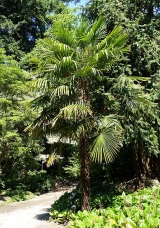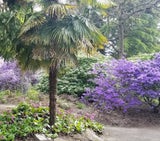- In the Garden
- >
- Gardens
- >
- Gardens I-P
- >
- Japanese Garden
- >
- Trachycarpus fortunei
Trachycarpus fortunei
Common name: Windmill palm
Trachycarpus fortunei is one of the few palms that will survive our damp, chilly winters. It is native to China, but our large specimens lives in the Japanese bed. During the construction of the Visitor Centre, it was moved there from the entry area of the Garden because this bed was the only place that had room for it. Several smaller specimens are found around the Garden
Trachycarpus fortunei is now native to China, but once grew in this area and is very hardy. There are two other palms also planted here, Trachycarpus wagneriana, which has slightly smaller palm fronds, and the European palm, Chamaerops humilis. These plantings around the city were coordinated by the Pacific Northwest Palm and Exotic Plants Society.
Erica's Original Notes
Palms are members of the Arecaceae family. Of course, one associates palms with warm climates, so it is unusual to find a Chinese windmill palm, Trachycarpus fortunei, growing in our fair city. But, as you see, ours are located in sheltered spots which helps to keep their growing tips from rotting.
Palms are second only to grasses in their usefulness to man, providing us with oil for soap, margarine, candles, machinery and cosmetics, and, of course, the leaves are used in a thousand ways from roofing to grass skirts.
Palm fronds were used on Palm Sunday, but in Northern Europe pussy willows were used as a substitute.
Photo of our tree by Daderot - via Wikimedia Commons
Photo of tree in Garden in spring by Tresa Horney


